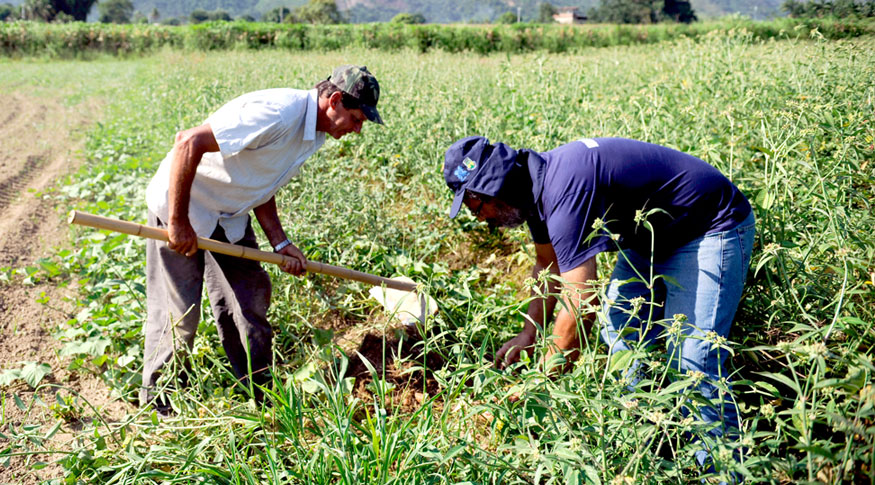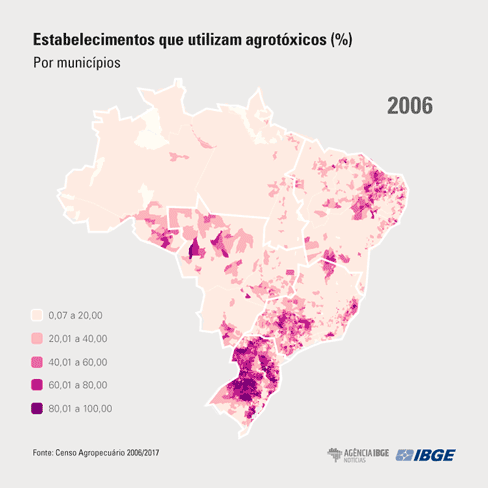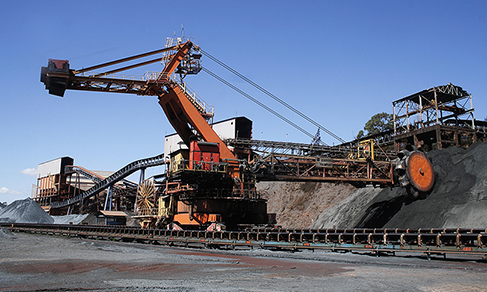100th Anniversary of Census of Agriculture
Atlas of Rural Area depicts diversity and inequalities in the Brazilian field
December 15, 2020 10h00 AM | Last Updated: December 16, 2020 06h13 PM
Highlights
- Study makes an unprecedented geographic analysis of the definitive results of the 2017 Census of Agriculture
- Publication can be accessed free of charge in digital format either on the IBGE website or on the Interactive Geographic Platform (PGI).
- Atlas shows that black or brown producers are concentrated in small establishments and that whites are the majority as the area increases.
- Average area of establishments in the Central-West (322 hectares) is almost five times greater than the national average (69 hectares).
- In the Atlantic Forest biome, only 24.2% of establishments have areas destined to forests, either native or planted.
- Proportion of establishments that use pesticides rises 22.9% in 11 years.
- Rural tourism appears as a source of income for agricultural establishments.
As part of the events to celebrate the 100th Anniversary of the Census of Agriculture, the IBGE releases today (15) the second edition of the Atlas of Brazilian Rural Area. The publication makes an unprecedented geographical analysis of the definitive results of the 2017 Census of Agriculture, but also uses other sources from the Institute itself - such as the publication Areas of Influence of Cities (Regic 2018), the Municipal Livestock Survey (PPM) and the Municipal Agricultural Production (PAM) - in addition to information from external sources, such as the National Institute of Colonization and Agrarian Reform (Incra) and the National Indian Foundation (Funai).
In almost 250 pages of maps, graphs, tables and texts, the Atlas provides information on the characteristics of producers and agricultural establishments, highlighting the territorial diversity and inequality present in the 5,073,324 establishments surveyed in the country.
“The complexity of the issues present in the Brazilian rural space requires an analysis with a multidisciplinary approach of the social, economic, environmental, political and cultural dimensions”, explains the geographer in charge of the project, Adma Hamam de Figueiredo.
The publication can be accessed for free on the IBGE website and on the Interactive Geographic Platform (PGI). Through the PGI, data can be crossed,other maps can be created and maps and tables can be downloaded in various formats .
Black and brown managers are minority
For the first time, the Atlas brings information about the color or race of the manager of the establishment. This allows for unprecedented analyzes as to the spatial distribution of the producer according to their color or race, as well as the crossing of this variable with the area of the establishments, among other subject matters. According to the 2017 Census of Agriculture, about 47.9% of the agricultural establishments had producers self-declared as white, a higher proportion than that of establishments with brown (42.6%), black (7.8%), Indigenous (0.8) %) and yellow persons (0.6%).
Inequality is reflected in the distribution of agricultural establishments' areas. Among the producers who run establishments with a total area of up to 1 hectare, 57.9% declared to be brown, 25.5%, white, 13.6%, black, 8.3%, indigenous and 1.8%, yellow. In establishments with more than 500 hectares, 72.2% of the owners/producers are white, 23.9% brown, 2.5% black, 0.4% indigenous and 0.06% yellow. That is, the larger the area of the establishments, the greater the predominance of selfdeclared white producers.
In establishments with areas ranging between 1,000 and 10,000 hectares, there are more than three times as many white owners (74.7%) compared to blacks or browns (23.8%). In the last range established by the survey, of more than 10,000 hectares, the proportion of these groups is 79% against 18.9%.
“Data reflect the process of occupation and appropriation of Brazilian territory since the beginning of the Portuguese invasion and colonization," says IBGE geographer Daiane de Paula Ciriáco. She adds that, with the subsequent laws that established access to land only through purchase, the exclusion of indigenous peoples and enslaved populations of African origin was evident, with visible repercussions nowadays.

Land size in Brazil is still uneven
The average area of an agricultural establishment in Brazil is 69 hectares, with great regional variation. The largest number of establishments remains in the hands of small landowners. The very limited portion of the areas they havey reflects the Brazilian land concentration.
If, on the one hand, 81% of agricultural establishments in the country had up to 50 hectares, on the other hand, they occupied only 12.8% of the total area of establishments in Brazil. On the other hand, only 0.3% of the number of establishments had more than 2,500 hectares, however they represented 32.8% of the total area of agricultural establishments in the country.
Data become closer to reality when viewed regionally. The average area of establishments in the Central-West (322 hectares) is almost five times greater than the national average (69 hectares). In addition, 12.8% of the area of establishments housed more than 70% of the employed persons, especially in establishments with less than 50 hectares. In contrast, in establishments over 2,500 hectares, this rate does not reach 5%.
“If in the past, the Central-West was already characterized by ultra-extensive cattle ranching, which already led to a concentration of land ownership, at present this process has been accelerated by the expansion of soybean and corn commodities and cattle ranching”, explains Ms. Figueiredo.
Livestock, in fact, is the main activity in the field, especially in the largest establishments, followed by temporary farming. Together, they are carried out in more than 80% of establishments in the country and, among establishments over 2,500 hectares, they reach 90%. In temporary crops, cassava and soybean highlight the country's regional inequalities. The former, strongly marked by production in establishments of up to 50 hectares (64.2%), and the latter, by production in establishments with more than 2,500 hectares (39.5%).
With regard to the legal condition of the land, own land predominates in all area groups, with rates above 80%, reaching 90.1% among establishments with more than 2,500 hectares. Settlement and occupation practically occurt only in establishments of up to 50 hectares (91.4% and 92.3%, respectively), especially in the Northeast.
In addition to all such inequalities those related to the sex of the producer, with establishments run by women representing less than 10% of the areas of the establishments, although in number of establishments they are responsible for about 18% of the total. Consequently, the average area of these establishments is much smaller, 36 hectares, almost half the average of those run by men.
Land use in biomes needs investment in technology and conservation
The analysis in the Atlas demonstrates the need for greater investment in technology, in soil management and conservation practices and in the preservation or restoration of permanent preservation areas, in order to guarantee better environmental quality and sustainability of natural resources.
“In Brazil, 26% of all establishments still use conventional cultivation, in which, in general, there is a lot of soil loss”, explains IBGE forest engineer Luciana Temponi. In addition, more than half of the producers do not use any of the agricultural practices for the benefit of the soil investigated in the Census of Agriculture, such as level planting, crop rotation, protection of hillsides, recovery of riparian forest or reforestation in spring areas. “In states like Rondônia, Tocantins, Mato Grosso and Goiás, more than 60% of establishments do not use any of those best practices”, points out Ms. Temponi.
Only 24.2% of land use in establishments in the Atlantic Forest biome are destined to forests, natural or planted, and to preservation areas. In the Cerrado, considered the birthplace of waters, reforestation practices for protecting springs and recovering riparian forests were reported by less than 4.0% of establishments in the states of Goiás and Tocantins, which are central to the biome. In the Pantanal, due to its favorable environmental characteristics, pastures - natural or planted - represent more than 67% of the area of the establishments, the highest percentage among all biomes.
In the Caatinga, two aspects, more evident than in all other biomes, call attention: the 19.9% of establishments using Agroforestry Systems and the highest percentage of pasture areas were reported as having some degradation. The Pampa has 83.5% of the establishments carrying out agriculture and livestock farming. The Amazon biome comprises about 49% of the country and is an exception in terms of area occupied by establishments, with only 20%. Although the percentage of the area of establishments occupied by forests is, on average, the highest among biomes, it still does not reflect the 80% to be preserved, as established in the environmental legislation in force.
Proportion of establishments using pesticides grows 22,9%
In the chapter dedicated to technology, information and knowledge, data on the use of polluting chemical inputs stand out. The proportion of establishments that admitted using pesticides increased by 22.9% in the last 11 years, from 27.0% in 2006 to 33.1% in 2017. The increase occurred in all Major Regions, with the Central-West presenting the greater increase in percentage points (13.3) compared to 2006.

In 2017, 83% of agricultural establishments had access to the electricity, a result 22% higher when compared to 2006. If electricity access is sorted out, Internet is still scarce in rural areas. Among the Major Regions, it was present in less than 30% of establishments. However, in 2006, only 1.5% of establishments had access to the Internet.
Concerning machinery - tractors, harvesters and planters - the average occurrence is 21.8% in the country, being lower in the Northeast, where only 3.0% of establishments have some machinery. The positive highlight was the Central-West, with around 40% of establishments equipped with some machinery.
Rural Tourism is source of revenue for owners
The Atlas also devotes an entire chapter to geographic analysis that describe the different ways by which the agricultural establishments get extra income. “Other revenues” means the values obtained from activities other than those related to agriculture and livestock, such as income from divestment, rural tourism services, mineral exploitation, craft activities, among others.
The number of establishments that present other revenues is substantially significant in the municipalities that comprise the Legal Amazon and the Northeastern Semi-Arid Areas. The highlight is the Municipality of Monte do Carmo, in Tocantins, where 66.2% of the total income of agricultural establishments come from those other revenues.
In Santa Cruz de Minas (MG), 100% of agricultural establishments obtained revenues from rural tourism and the amount of money from tourism corresponds to 50.6% of the total revenues of the establishments. Poá, in São Paulo, comes in second place, with 24.7% of the establishments' total revenue coming from rural tourism; however, only 14.3% of the establishments reported obtaining some income from this activity. In absolute values, the states with the highest values for other revenues as a whole are Paraná, Rio Grande do Sul and Minas Gerais.




















